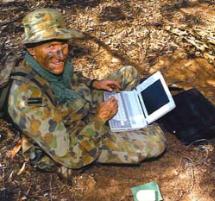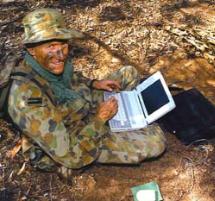CQU alumnus serves in Banda Aceh
Published on 19 May, 2005
CQU graduate and ABC broadcaster Phil Smith reports on his experiences in Banda Aceh in the wake of the devasting Boxing Day tsunami....
.... that may be the most gruesome operation I’ve ever experienced, but it’s probably the most satisfying. We worked hard, made a difference, and the international media got the message.
I had flown into Medan from Canberra, via Sydney and Singapore. The Army Major I was replacing had flown in from Banda Aceh on his way home via Butterworth. His statement summed up the half hour we had for the hand over.
“It’s the smell that will stay with you, but the worst of it is probably over now".
As a RAAF Specialist Reservist, I had been called up for the tsunami relief mission – Operation Sumatra Assist – in the role of Officer in Charge Media Operations. Not since 140 cameras turned up for a press conference prior to the East Timor expedition had I seen such media focus on the Australian Defence Forces.
 Essentially Australia had to do good and be seen to be doing good. The latter is the key role of the First Joint Public Affairs Unit. IJPAU is now the most deployed unit in the ADF and its operational tempo demands the use of Reservist and Regular members from all three services. Twenty-four hours later, at the ANZAC Hospital in Aceh, I met my team in our makeshift office at the morgue. A tri-service camera crew provided stills, video and stories to the Australian and international media via the Defence Media Room in Canberra. An Army Captain provided liaison between civilian media in Aceh and our Defence Forces. Back at the Medan head quarters another RAAF SR Squadron Leader provided the interface with the Task Force Commander.
Essentially Australia had to do good and be seen to be doing good. The latter is the key role of the First Joint Public Affairs Unit. IJPAU is now the most deployed unit in the ADF and its operational tempo demands the use of Reservist and Regular members from all three services. Twenty-four hours later, at the ANZAC Hospital in Aceh, I met my team in our makeshift office at the morgue. A tri-service camera crew provided stills, video and stories to the Australian and international media via the Defence Media Room in Canberra. An Army Captain provided liaison between civilian media in Aceh and our Defence Forces. Back at the Medan head quarters another RAAF SR Squadron Leader provided the interface with the Task Force Commander.
Our interpreter was a local woman. Bunda had taught English and worked in the hospital before 600 of the 900 staff were killed on Boxing Day 2004.
“Oh sh*t, that’s bigger than last week!”.
“I’m getting outside.”.
“Sir! I cannot swim.”.
“It’s all right Bunda. There isn’t another big wave coming.”.
“Yeah, right Sir. How long have you been a qualified seismologist?”.
Earthquakes and tremors continued, providing more grist for the media mill, as everyone from 'A Current Affair' to the 'Jakarta Post' wanted access to Australia’s combat engineers, field hospital, aircraft and HMAS Kanimbla.
As a Public Affairs Officer it’s my job to get my commander’s messages out to the targets he chooses. It wasn’t hard to tell the story of our sailors, soldiers, airmen and women as they did Australia proud in the eyes of the world. I treasure the image of Indonesian and Australian nurses embracing at the hand-over of the infectious diseases ward. The videotape of the Red Cross/Red Crescent taking over the water purification and distribution point was a land mark story. Working and clearance divers in the filthy Aceh River became heroes as they raised sunken fishing vessels. Teams loaded and unloaded plane loads of supplies from New South Wales to Sumatra.
Once again the nickname ‘Digger’ was in the headlines, but it was a senior American reporter who caught the irony.
The Boston Globe carried the story of Aussie Diggers, and their officers, shovels in hand, clearing drains and debris – digging in the black sludge.
“The body trucks haven’t come around yet, Sir.”.
“You’ve been at that site three days?”.
“Yep. So we’ve given the bodies names. The blokes say, ‘Good morning’ to them when we arrive to start work. They call the little girl Jessica. She’s the one with just the face and one arm sticking out...”.
 “That’s my daughter’s name.”.
“That’s my daughter’s name.”.
It was the small encounters that brought home the awful individual reality behind the big picture stories going out through electronic and print media.
Then there were the images that simply beggared belief.
Imagine picking your way among the ruins of family homes, collapsed by earthquake and blackened by gas fires before they were swamped in mud carried by the unimaginable wave.
A 60 ft fishing boat is probably still sitting on the roof of a two-storey house. Do the rough sums. That vessel weighs around 35 tonnes.
Days were long whether operating in the theatres, maintaining choppers at the muddy airfield, or driving a bulldozer to clear rubble. Around 10 percent of Task Force 629 was Reservists. In their two or three day old cams, no one could tell the difference. At the end of the day it didn’t make a difference.
“Here come the mossies again. Pass the spray Boss.”.
“The breeze should get up again soon.”.
“Yeah, and the smell.”.
“I reckon there must still be one just under the mud near here.”.
“Might be a dead dog?”.
“Yeah, right!”.
The Major was right. I remember the smells. Yet more than that, I recall a job done well by almost a thousand people bringing individual skills to the task: Reservists and Regulars, from surgeons to sailors. As one senior Army officer pointed out over a ration pack in the morgue one night, “We all put our pants on the same way – one leg at a time.”.
It’s called the common touch.
ENDS.
SQNLDR PHIL SMITH 23SQN.

